Hottub, Swimming Pool
Pseudomonas Infections and Spa Pools: What You Need to Know
Pseudomonas Infections and Spa Pools: What You Need to Know
While spa pools and hot tubs are designed to provide relaxation and enjoyment, they can also harbor bacteria that cause infections. One of the most common concerns is *Pseudomonas aeruginosa*, a bacterium known to cause folliculitis, a skin infection. The Health and Safety Executive (HSE) highlights that numerous outbreaks of folliculitis caused by *P. aeruginosa* are associated with spa pools and hot tubs [8]. It’s important to be informed and take the necessary precautions to minimize your risk of contracting this infection.
This blog post explains what *Pseudomonas aeruginosa* is, how it can thrive in spa environments, what the symptoms are and how you can protect yourself and your family.
What is *Pseudomonas aeruginosa*?
*Pseudomonas aeruginosa* is a common bacterium found in water and soil. It’s particularly adept at thriving in warm, moist environments such as spa pools [7]. It can cause various infections, but in spa pools, it is most commonly associated with folliculitis. This is an infection of the hair follicles and can be very unpleasant.
How Do *Pseudomonas* Infections Occur in Spa Pools?
- Warm Water: Like *Legionella*, *Pseudomonas aeruginosa* thrives in warm water [7]. The typical operating temperature of spa pools makes them a perfect environment for this bacterium to grow [3].
- High Bather Loads: Spa pools with a high number of users often have a greater concentration of organic matter such as sweat, skin cells, and hair, which provide nutrients for bacterial growth [4, 10].
- Poor Disinfection: If disinfection levels are not maintained correctly, bacteria can proliferate rapidly in the spa water [20, 21].
- Biofilms: *P. aeruginosa* can form biofilms in pipework, filters, and other parts of the spa system. These biofilms can protect the bacteria from disinfectants [32, 33].
Symptoms of *Pseudomonas* Folliculitis
- Red Rash: The most common symptom is a red, itchy rash that appears on the skin [8].
- Pustules or Pimples: The rash often includes small, red bumps or pustules resembling pimples, particularly around hair follicles [8].
- Itching: The affected area can become very itchy and uncomfortable.
- Timing: The rash typically appears within 8 hours to 5 days after using a contaminated spa pool [8].
It is worth noting that children are generally more susceptible to *Pseudomonas* folliculitis than adults [8].
Prevention and Control Measures
- Proper Disinfection: Maintain appropriate disinfectant levels at all times [20, 21]. Regularly test your water and adjust disinfectant as needed.
- Regular Water Replacement: Change the water according to HSE guidelines, especially for domestic hot tubs used for business [13, 28].
- Effective Filtration: Ensure the spa pool’s filtration system is working effectively and is cleaned regularly [19, 26].
- Regular Cleaning: Keep all parts of the spa pool, including the waterline, jets, and pipework, clean to prevent biofilm formation [29-31].
- Shower Before Use: Encourage users to shower before entering the spa to reduce the amount of organic matter introduced into the water [3, 37].
FAQs
What is *Pseudomonas aeruginosa*?
*Pseudomonas aeruginosa* is a bacterium that can cause infections, including folliculitis, and is common in water and soil [7].
How does *Pseudomonas aeruginosa* cause folliculitis?
It infects the hair follicles, causing a red, itchy rash with small, red bumps or pustules [8].
What are the symptoms of *Pseudomonas* folliculitis?
Symptoms include a red, itchy rash, often with pustules or pimples, that appears 8 hours to 5 days after using a contaminated spa pool [8].
How can I prevent *Pseudomonas* infections in my spa pool?
Maintain proper disinfection, replace water regularly, ensure effective filtration, clean the spa frequently, and shower before use [17, 21].
How often should I test for *Pseudomonas aeruginosa* in my spa pool?
Microbiological testing for *Pseudomonas aeruginosa* should be carried out monthly [13, 14].
By staying informed and proactive, you can help ensure that your spa pool remains a safe and enjoyable environment.












